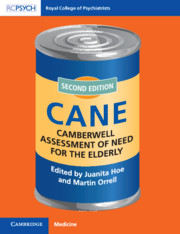Book contents
- Camberwell Assessment of Need for the Elderly
- Camberwell Assessment of Need for the Elderly (CANE)
- Copyright page
- Contents
- Figures
- Tables
- Contributors
- Acknowledgements
- Chapter 1 An Introduction to Needs Assessment and Use of the Camberwell Assessment of Need for the Elderly
- Chapter 2 Self-Reported Needs of People with Dementia Living at Home
- Chapter 3 Needs of Older Primary Care Patients
- Chapter 4 Unmet Needs of Older Persons with and Without Depression in Residential Homes
- Chapter 5 Needs of Older People Living Alone
- Chapter 6 Needs Assessment of People with Dementia and Impact of Caregiver Burden
- Chapter 7 Crisis and Assessment of Need in Dementia
- Chapter 8 Needs of People with Young-Onset Dementia
- Chapter 9 Needs of Older People in Long-Term Care Settings
- Chapter 10 Needs and Healthcare Costs in Old Age
- Chapter 11 The Future of Needs Assessment Research
- Instructions for the CANE
- Index
- References
Chapter 11 - The Future of Needs Assessment Research
Published online by Cambridge University Press: 10 June 2021
- Camberwell Assessment of Need for the Elderly
- Camberwell Assessment of Need for the Elderly (CANE)
- Copyright page
- Contents
- Figures
- Tables
- Contributors
- Acknowledgements
- Chapter 1 An Introduction to Needs Assessment and Use of the Camberwell Assessment of Need for the Elderly
- Chapter 2 Self-Reported Needs of People with Dementia Living at Home
- Chapter 3 Needs of Older Primary Care Patients
- Chapter 4 Unmet Needs of Older Persons with and Without Depression in Residential Homes
- Chapter 5 Needs of Older People Living Alone
- Chapter 6 Needs Assessment of People with Dementia and Impact of Caregiver Burden
- Chapter 7 Crisis and Assessment of Need in Dementia
- Chapter 8 Needs of People with Young-Onset Dementia
- Chapter 9 Needs of Older People in Long-Term Care Settings
- Chapter 10 Needs and Healthcare Costs in Old Age
- Chapter 11 The Future of Needs Assessment Research
- Instructions for the CANE
- Index
- References
Summary
People are living longer, and the growth of the ageing population has led to an increase in demand for the use of health services. As life expectancy is extended, so the prevalence of long-term conditions and multi-morbidity increases. While healthy ageing is achievable, the distribution of health depends on social and economic determinants, and improvements in health outcomes are associated with higher socioeconomic status.1 Healthy ageing is linked to physical, mental, functional and social wellbeing but also depends on the role older people have in society and the reduction of age-discriminatory health inequalities.2 Currently, ageing is associated with increased use of health services, but older people are generally considered lower priority for treatment and receive poorer-quality care.3 Moreover, austerity measures over the last decade have led to a widening of social and economic inequalities, which have resulted in poorer health and increasing health inequality.4 Constraints in spending on health and social care raise questions as to how health and social services will use the resources available to meet the needs of the older populations they serve.
- Type
- Chapter
- Information
- Camberwell Assessment of Need for the ElderlyCANE, pp. 97 - 104Publisher: Cambridge University PressPrint publication year: 2021

